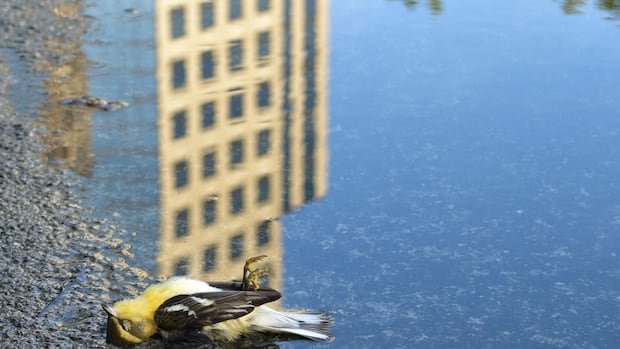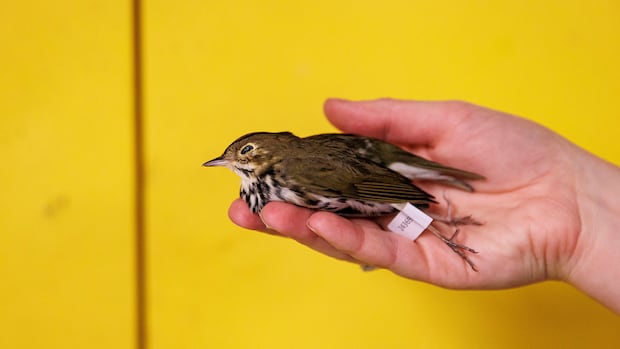Last Wednesday, a volunteer organization that searches and maintains bird safety records found more than 300 birds that had crashed into windows in the Greater Toronto Area.
Most did not survive.
It’s an easy problem to fix, according to Michael Mesure, executive director of the Fatal Light Awareness Program (FLAP). But a lack of incentives means few make the necessary changes, he told CBC Toronto.
During a bird patrol outing in Markham on Wednesday, Mesure found 20 birds around a single building in Markham. He cautiously placed the only survivor of the group in a paper bag with the intention of taking him to a rehabilitation center.
“There’s not much we can do other than keep him calm and as stress-free as possible in the hopes that he can recover from it,” Mesure said while on patrol.
“It’s tragic that the death rate is so high.”
Starting in 2022, Toronto has required windows in certain new construction to have collision deterrence, but the regulation does not apply to most residential or existing buildings. According to the latest self-reported assessment of a national bird-safe cities program obtained by CBC Toronto, the standard is not enforced and “there are no completed buildings in the city that comply” with the guideline.
To make a difference, Mesure said the guidelines need to be enforced.
“We have to modernize these buildings if we ever have a chance to overcome this problem,” he said.
The City of Toronto did not respond to CBC’s request for comment in time for the deadline stated in the request.
The culprit buildings have windows that reflect vegetation.
Over the past 50 years, North American bird populations have declined by billions, according to a 2019 report in the journal. Science.
This time of year is particularly deadly, Mesure said, because it’s when many species migrate. In the last month, about 2,000 birds have died from collisions with buildings around the GTA, according to the Global Bird Collision Mapper, a digital reporting tool that allows volunteers and members of the public to record, enter and track the locations of bird collisions with buildings.
During patrols, FLAP volunteers record any injuries or deaths they find in a database and take the injured birds to rehabilitation centers. Some days they find hundreds of birds, Mesure said.
Most killers are buildings less than 20 meters tall with windows that reflect nearby trees, bushes or grassland, Mesure said. Birds struggle to distinguish between reflections and real vegetation.
“These birds are not stupid. We have created an illusion that causes harm. It is relatively easy to rectify,” he said.
Collisions can be avoided by making the window surface visibly different from nature, so that birds can see. This could look like opaque patterns or dots printed on the glass, Mesure said.
Because of its reporting, Mesure said FLAP knows which buildings kill the most birds, but it’s difficult to incentivize building owners to treat their windows because doing so is expensive.
Replacing a window can cost hundreds of dollars, he said.
“There really is nothing in return for people other than the goodness of their heart,” he said. “It’s not like… that’s somehow going to put the money back in the owner’s pocket.”
‘Bird-friendly’ cities
Markham requires new construction to include collision deterrence strategies in site plans. Markham’s director of sustainability and asset management, Graham Seaman, said the city also has awareness campaigns to encourage people to have bird-safe glass on private property.
“We really don’t have any tools to force anyone to retrofit,” Seaman said. “Yeah [complaints get] If it is significant, we can call the building owner and encourage him.”
Toronto is a Na-certified “bird-friendly city”ture Canada, a national conservation charity. To obtain certification, cities must meet a minimum requirement for threat reduction, environmental protection and community outreach.
The Bird Friendly Cities certification program does not include a category to track compliance with window requirements.
Window strikes kill up to a million birds a year in Canada, especially during spring and early October migrations. Some Canadian cities are testing solutions, such as bird-friendly new building designs.
Autumn Jordan, organizer of the bird-friendly cities program, says the lack of enforcement is not unique to Toronto. He said the city is a leader in the program and was one of the first in North America to agree to be bird-friendly.
“Despite the lack of enforcement, more buildings are still being built with bird-proof glass,” Jordan said.
Difficulties in collecting data
Toronto and Markham’s bird safety plans defer data collection and disclosure of existing buildings to FLAP. Jordan said this is common in all Canadian municipalities, not just the GTA.
But Mesure said FLAP still faces challenges collecting data, including being kicked off private property while patrolling.
“Sometimes security and building owners don’t want us here,” he said.
He said birds need to be found quickly for the data to be accurate because scavengers often take their bodies. Or, if they are injured, they may fly away and die later somewhere else.
He said not having records of the scope of the problem makes it more difficult to advocate for changes to be made.
“People often need to see it to believe it,” he said.









